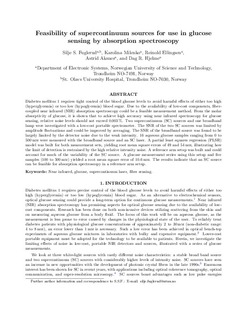| dc.contributor.author | Fuglerud, Silje Skeide | |
| dc.contributor.author | Milenko, Karolina Barbara | |
| dc.contributor.author | Ellingsen, Reinold | |
| dc.contributor.author | Aksnes, Astrid | |
| dc.contributor.author | Hjelme, Dag Roar | |
| dc.date.accessioned | 2019-07-26T07:11:41Z | |
| dc.date.available | 2019-07-26T07:11:41Z | |
| dc.date.created | 2019-07-25T15:57:15Z | |
| dc.date.issued | 2019 | |
| dc.identifier.citation | Proceedings of SPIE, the International Society for Optical Engineering. 2019, 11073 . | nb_NO |
| dc.identifier.issn | 0277-786X | |
| dc.identifier.uri | http://hdl.handle.net/11250/2606493 | |
| dc.description.abstract | Diabetes mellitus 1 requires tight control of the blood glucose levels to avoid harmful effects of either too high (hyperglycemia) or too low (hypoglycemia) blood sugar. Due to the availability of low-cost components, fiber- coupled near infrared (NIR) absorption spectroscopy could be a feasible measurement method. From the molar absorptivity of glucose, it is shown that to achieve high accuracy using near infrared spectroscopy for glucose sensing, relative noise levels should not exceed 0:003 %. Two supercontinuum (SC) sources and one broadband lamp were investigated with a low-cost portable spectrometer. The SNR of the two SC sources was limited by amplitude fluctuations and could be improved by averaging. The SNR of the broadband source was found to be largely limited by the detector noise due to the weak intensity. 16 aqueous glucose samples ranging from 0 to 500mm were measured with the broadband source and an SC laser. A partial least squares regression (PLSR) model was built for both measurement sets, yielding root mean square errors of 49 and 54mm, illustrating how the limit of detection is restrained by the high relative intensity noise. A reference arm setup was built and could account for much of the variability of the SC source. A glucose measurement series using this setup and five samples (100 to 500mm) yielded a root mean square error of 10:6mm. The results indicate that an SC source can be feasible for absorption spectroscopy in a reference arm setup. | nb_NO |
| dc.language.iso | eng | nb_NO |
| dc.publisher | Society of Photo Optical Instrumentation Engineers (SPIE) | nb_NO |
| dc.relation.uri | https://www.spiedigitallibrary.org/conference-proceedings-of-spie/11073/2524005/Feasibility-of-supercontinuum-sources-for-use-in-glucose-sensing-by/10.1117/12.2524005.full?SSO=1 | |
| dc.title | Feasibility of supercontinuum sources for use in glucose sensing by absorption spectroscopy | nb_NO |
| dc.type | Journal article | nb_NO |
| dc.type | Peer reviewed | nb_NO |
| dc.description.version | acceptedVersion | nb_NO |
| dc.source.pagenumber | 7 | nb_NO |
| dc.source.volume | 11073 | nb_NO |
| dc.source.journal | Proceedings of SPIE, the International Society for Optical Engineering | nb_NO |
| dc.identifier.doi | 10.1117/12.2524005 | |
| dc.identifier.cristin | 1712750 | |
| dc.relation.project | Norges forskningsråd: 248872 | nb_NO |
| dc.relation.project | Samarbeidsorganet mellom Helse Midt-Norge og NTNU: 46055510 | nb_NO |
| dc.description.localcode | © 2019 Society of Photo Optical Instrumentation Engineers. One print or electronic copy may be made for personal use only. Systematic reproduction and distribution, duplication of any material in this paper for a fee or for commercial purposes, or modification of the content of the paper are prohibited. | nb_NO |
| cristin.unitcode | 194,63,35,0 | |
| cristin.unitname | Institutt for elektroniske systemer | |
| cristin.ispublished | true | |
| cristin.fulltext | postprint | |
| cristin.qualitycode | 1 | |
